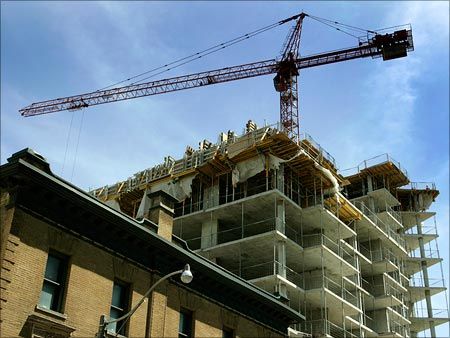 Launch of new residential projects in top eight cities -- Ahmedabad, Bengaluru, Chennai, Hyderabad, Kolkata, Mumbai, National Capital Region (NCR) and Pune -- came down by 41 per cent in first half of 2017.
Launch of new residential projects in top eight cities -- Ahmedabad, Bengaluru, Chennai, Hyderabad, Kolkata, Mumbai, National Capital Region (NCR) and Pune -- came down by 41 per cent in first half of 2017.
Hit by demonetisation and Real Estate (Regulation & Development) Act compliance, launch of new residential projects in top eight cities -- Ahmedabad, Bengaluru, Chennai, Hyderabad, Kolkata, Mumbai, National Capital Region (NCR) and Pune -- came down by 41 per cent in first half of 2017, a seven-year low, according to a report by Knight Frank.
Launches were 73 per cent down when compared with the first half of 2013.
Chennai was the only market to record a marginal four per cent year-on-year rise in launches.
Ahmedabad and the NCR and were the worst hit, with launches plummeting 79 per cent and 73 per cent, respectively. Both the cities are believed to have high cash component in home sales.
In Mumbai, launches were down 36 per cent.
Launches in Bengaluru, India's technology hub, reduced by 42 per cent. South Bengaluru continued to lead in both new launches and sales, courtesy the healthy congregation of large IT hubs and, thus, being preferred by local populace and expatriate population.
"The inclusion of Bengaluru in the Smart City list is expected to have a far reaching impact on the residential market in the forthcoming years, as that would lead to improved infrastructure in the city," Shantanu Mazumder, director, Bengaluru, Knight Frank, said.
Sales volume fell by 11 per cent on a yearly basis, lowest first-half sales in the past five years, the report said.
“Demonetisation, Rera and GST all came in a gap of six months… they are bound to have a short-term impact on sales,” said Shishir Baijal, chairman, Knight Frank India.
However, when compared on a quarter-on-quarter basis, sales grew 11 per cent. A large chunk of this, the report says, was due to the pick-up in the affordable housing segment.
Launches in the under-Rs 50-lakh price segment rose to 71 per cent from 52 per cent during the same period last year.
The NCR, Kolkata, Pune and Ahmedabad markets drove the revival with around 80 per cent of the launches being in the sub-Rs 50 lakh segment.
“The GST will bring down the cost of construction for the developers, but it remains to be seen whether they will pass on the benefit to the consumers or not. Rera, on its part, will usher in transparency. Global investors are now looking at the Indian real estate sector as an attractive proposition given the regulatory, policy changes,” said Ghulam Zia, executive director for advisory, retail and hospitality at Knight Frank.
Unsold inventory, according to the report, at 596,044 units was lowest across these eight cities, and witnessed a drop of 10% compared to the previous corresponding period (H1-2016).
“NCR was the worst market with over four years of inventory. There has been a surge in inventory in the ‘ready for possession’ category,” Knight Frank said.
On the office properties side, transactions fell by 10 per cent to 18.1 million sq ft in H1 2017. The 5 per cent decline in supply saw 17.9 mn sq ft added to the office space inventory, Knight Frank said.
At 12 per cent, vacancy levels were at the lowest since 2012 when it was 21 per cent, it said.
Average rental values across six cities grew at seven per cent y-o-y during H1 of 2017.
While Mumbai saw flat y-o-y rental growth, Hyderabad and Bengaluru experienced the strongest rental growth at 14 per cent and eight per cent y-o-y, respectively.












 © 2025 Rediff.com -
© 2025 Rediff.com -